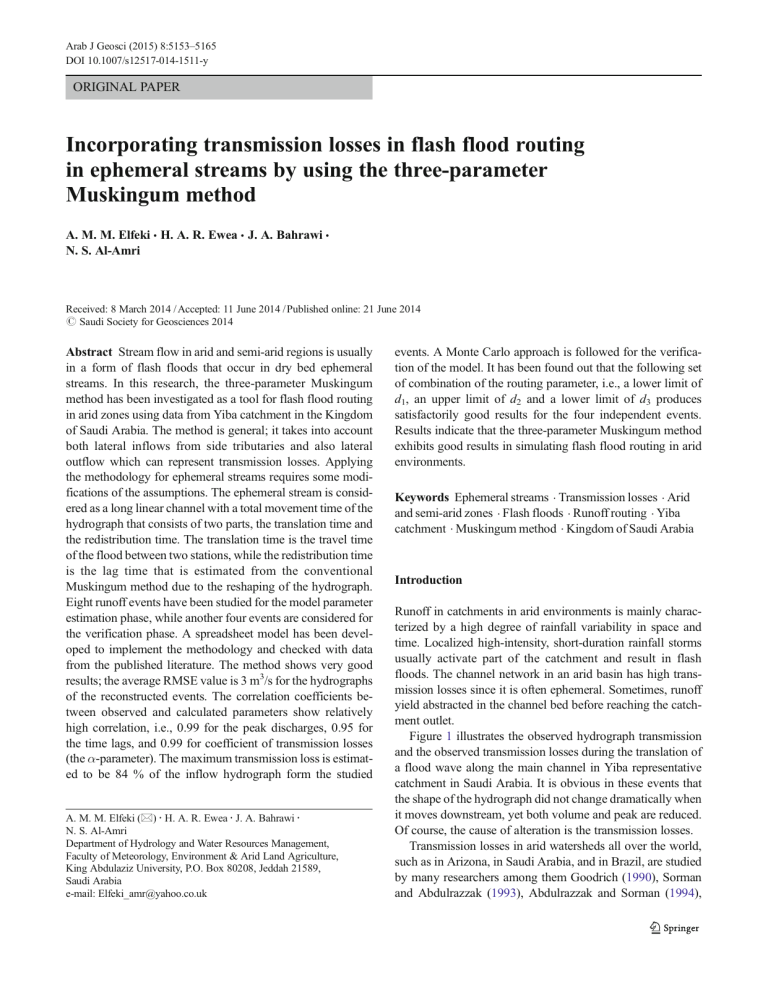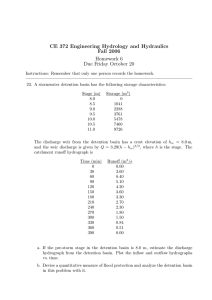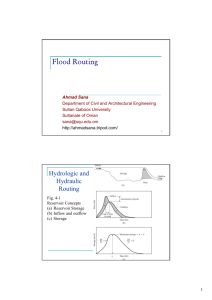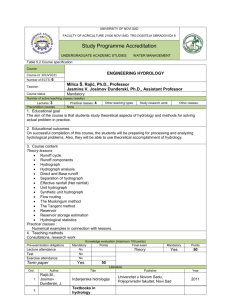
Arab J Geosci (2015) 8:5153–5165 DOI 10.1007/s12517-014-1511-y ORIGINAL PAPER Incorporating transmission losses in flash flood routing in ephemeral streams by using the three-parameter Muskingum method A. M. M. Elfeki & H. A. R. Ewea & J. A. Bahrawi & N. S. Al-Amri Received: 8 March 2014 / Accepted: 11 June 2014 / Published online: 21 June 2014 # Saudi Society for Geosciences 2014 Abstract Stream flow in arid and semi-arid regions is usually in a form of flash floods that occur in dry bed ephemeral streams. In this research, the three-parameter Muskingum method has been investigated as a tool for flash flood routing in arid zones using data from Yiba catchment in the Kingdom of Saudi Arabia. The method is general; it takes into account both lateral inflows from side tributaries and also lateral outflow which can represent transmission losses. Applying the methodology for ephemeral streams requires some modifications of the assumptions. The ephemeral stream is considered as a long linear channel with a total movement time of the hydrograph that consists of two parts, the translation time and the redistribution time. The translation time is the travel time of the flood between two stations, while the redistribution time is the lag time that is estimated from the conventional Muskingum method due to the reshaping of the hydrograph. Eight runoff events have been studied for the model parameter estimation phase, while another four events are considered for the verification phase. A spreadsheet model has been developed to implement the methodology and checked with data from the published literature. The method shows very good results; the average RMSE value is 3 m3/s for the hydrographs of the reconstructed events. The correlation coefficients between observed and calculated parameters show relatively high correlation, i.e., 0.99 for the peak discharges, 0.95 for the time lags, and 0.99 for coefficient of transmission losses (the α-parameter). The maximum transmission loss is estimated to be 84 % of the inflow hydrograph form the studied A. M. M. Elfeki (*) : H. A. R. Ewea : J. A. Bahrawi : N. S. Al-Amri Department of Hydrology and Water Resources Management, Faculty of Meteorology, Environment & Arid Land Agriculture, King Abdulaziz University, P.O. Box 80208, Jeddah 21589, Saudi Arabia e-mail: Elfeki_amr@yahoo.co.uk events. A Monte Carlo approach is followed for the verification of the model. It has been found out that the following set of combination of the routing parameter, i.e., a lower limit of d1, an upper limit of d2 and a lower limit of d3 produces satisfactorily good results for the four independent events. Results indicate that the three-parameter Muskingum method exhibits good results in simulating flash flood routing in arid environments. Keywords Ephemeral streams . Transmission losses . Arid and semi-arid zones . Flash floods . Runoff routing . Yiba catchment . Muskingum method . Kingdom of Saudi Arabia Introduction Runoff in catchments in arid environments is mainly characterized by a high degree of rainfall variability in space and time. Localized high-intensity, short-duration rainfall storms usually activate part of the catchment and result in flash floods. The channel network in an arid basin has high transmission losses since it is often ephemeral. Sometimes, runoff yield abstracted in the channel bed before reaching the catchment outlet. Figure 1 illustrates the observed hydrograph transmission and the observed transmission losses during the translation of a flood wave along the main channel in Yiba representative catchment in Saudi Arabia. It is obvious in these events that the shape of the hydrograph did not change dramatically when it moves downstream, yet both volume and peak are reduced. Of course, the cause of alteration is the transmission losses. Transmission losses in arid watersheds all over the world, such as in Arizona, in Saudi Arabia, and in Brazil, are studied by many researchers among them Goodrich (1990), Sorman and Abdulrazzak (1993), Abdulrazzak and Sorman (1994), 5154 Arab J Geosci (2015) 8:5153–5165 Fig. 1 Observed hydrograph transmission between two stations: a station 422 and 401 for 10.5 km channel length (event 1st of May 1985), b station 423 and 424 for 33.2 km channel length (event 21st of May 1984) Wheater et al. (1997), and Costa et al. (2012). Goodrich et al. (1997) estimated infiltration rates in ephemeral streambeds to be as high as double to ten times the amount of infiltration rates on the hill slopes. Illangasekare and Morel-Seytoux (1984) estimated about 78 % of transmission losses reached the saturated zone in a case study in an aquifer at the Red Sea coast. Flood routing is important in the design of flood protection measures in order to estimate how the proposed measures will affect the behavior of flood waves in rivers so that adequate protection and economic solutions can be found (Wilson 1990). The study of the change of the shape of the hydrograph and its travel time down the channel is one of the main issues in flood routing methods. Among the many models used for flood routing, Kundzwicz and Strupczewski (1982) noted that the Muskingum method of flood routing has been extensively applied in river engineering practices since its introduction in the 1930s. Muskingum method is developed for perennial streams where the flow is continuous over the year round. The basic procedure assumes no lateral inflow or transmission losses along the main channel reach through which a flood is being routed. However, in arid environment, most streams are ephemeral and catchments are often ungauged. When performing flood routing in arid environment, the Muskingum parameters can be estimated using synthetic hydrograph methods (Chow et al. 1988) without using observed hydrograph because hydrograph data is often unavailable. The inflow hydrograph could be estimated based on these synthetic methods and the outflow hydrographs at the end of the reach are generated with traditional Muskingum technique without incorporating transmission losses. O’Donnell (1985) developed the three-parameter Muskingum method to incorporate lateral inflows to a channel reach in the routing procedure of river channels. The approach is used to estimate the rate of lateral inflows and reconstruct hydrographs in temperate region catchments. Tewolde (2005) has reviewed Muskingum flood routing techniques such as linear, non-linear, three parameters, Muskingum–Cunge, etc. Then applied the Muskingum– Cunge technique to Thukela catchment in South Africa and used parameters of Muskingum–Cunge method derived from reach and flow characteristics. It was found out that the Muskingum–Cunge method, with empirically estimated parameters (MC-E), and with variables estimated from an assumed section (MC-X), are applicable to ungauged catchments where observed data sets for river flows are unavailable. Elbashir (2011) has a recent review on various Muskingum methods; however, no review of the three-parameter Muskingum method is given. Elbashir applied both traditional Muskingum and Muskingum–Cunge methods on river Brosna in Ireland. Elbashir concluded that despite the simplicity of these methods and their wide applicability on most natural channels, their use is limited to certain conditions. The analysis has shown that both methods failed to simulate the outflow hydrograph in the river Brosna. Some recent research work on transmission losses has been reported in the literature by many researchers among them Costa et al. (2012, 2013) who developed a process-oriented, semi-distributed channel transmission losses model. However, one of the main issues in arid lands is the scarcity of runoff measurements, especially in Saudi Arabia, that render the use of distributed modeling approaches very difficult. The above-mentioned review showed the Muskingum techniques are mainly developed and used for river studies and yet no serious applications are made for ephemeral streams. On the other hand, since data availability is scarce in arid and semi-aid zones, consequently distributed or semidistributed modeling approaches are not an option. Therefore, the objective of the current research is to investigate the utilization of the three-parameter Muskingum method—as a lumped three-parameter model—in routing flash floods in ephemeral streams incorporating transmission losses. Observed inflow and outflow hydrographs from wadi Yiba catchment in the southwestern part of Saudi Arabia are used. An inverse modeling approach is used to estimate the model parameters from some events in the calibration phase. Then a forward modeling approach based on Monte Carlo method is utilized to make predictions of the outflow hydrographs of some other events and plotted against observed ones. Through Arab J Geosci (2015) 8:5153–5165 5155 this approach, the performance of flood routing procedure has been evaluated. At the end, the research work has shown the assumptions and ways of implementing the technique in ungauged reaches in arid catchments. The three-parameter Muskingum method The Muskingum routing procedure is a well-established method in hydrology (Chow et al. 1988). In its basic form, the procedure has two parameters, the channel time lag, Km, and the weighting parameter, x. However, both parameters do not consider lateral flow of flood in channels. Thus, a third parameter, α, is introduced to allow for the lateral movement of flood water (O’Donnell 1985). The incorporation of the parameter α in the continuity equation would transform the whole expression of the Muskingum method to a threeparameter model. The parameter α can be positive to represent a lateral inflow, or negative to represents transmission losses. O’Donnell (1985) expressed the three-parameter model as follows: dS I ð1 þ αÞ ¼ O þ dt ð1Þ where: S I O α is the channel storage is the inflow hydrograph into the channel segment is the outflow hydrograph from the channel segment, and is the coefficient of lateral flow. The empirical formula for the channel storage is given by S ¼ K m ½ð1 þ αÞxI þ ð1−xÞO ð2Þ been programmed in an Excel spreadsheet as will be explained later). The ∑ 3 d i does not necessarily lead to 1; i¼1 however, when α is zero, no lateral flow occurs, and consequently, ∑ 3 d i ¼ 1 , which is the conventional Muskingum i¼1 case. The three parameters, Km, x, and α, are related to d1, d2, and d3 by the following formulas (O’Donnell 1985), K m ¼ Δt d1 þ d2d3 ð1−d 3 Þðd 1 þ d 2 Þ d2 þ d2d3 x ¼ 0:5 1− d1 þ d2d3 α¼ d 1 þ d 2 þ d 3 −1 1−d 3 ð4Þ ð5Þ ð6Þ Equation 3 can be written in matrix formulation for the solution for the di coefficients as, 2 3 d1 ð7Þ ½OtþΔt ¼ ½I t ; I tþΔt ; Ot ⋅4 d 2 5 d3 The matrix inversion using the least square solution of Eq. 7 yields the three di coefficients as, 2 3 02 3 3 1−1 2 d1 It It 4 d 2 5 ¼ @4 I tþΔt 5⋅½I t ; I tþΔt ; Ot A ⋅4 I tþΔt 5⋅½OtþΔt ð8Þ d3 Ot Ot where, Km x is the channel time lag (the hydrograph movement time), and is a weighting parameter Equations 1 and 2 reduce to the classical Muskingum method when the α-parameter is equal to zero. Equations 1 and 2 are coupled and solved using the finite difference method in discrete time intervals, Δt, leading to an input– output formula as follows: OtþΔt ¼ d 1 I t þ d 2 I tþΔt þ d 3 Ot ð3Þ where d1, d2, and d3 are the coefficients that can be obtained by the matrix inversion least square solution (the method has The aforementioned matrix operations are formulated and executed on a spreadsheet using the built in matrix operation functions, such as transpose, inversion, and multiplication. Figures 2 and 3 show the design spreadsheet for that purpose. The first sheet, in Fig. 2, shows the calculations of the three di coefficients based on Eq. 8, while, Fig. 3 shows the calculation tables of the reconstructed outflow based on Eq. 3 with the di coefficients. The spreadsheet model has been checked by events from the literature (O’Donnell 1985) and produces identical results. It is important to emphasize the concepts of times in hydrograph translation. Chow et al. (1988) defined two times in the hydrograph transmission. The first is the time of translation of the flood which is the time of the translation of the 5156 Arab J Geosci (2015) 8:5153–5165 Fig. 2 Spreadsheet model for input of inflow and outflow and calculations of the di coefficients based on matrix operations Eq. 8 centroid of the input hydrograph to the output hydrograph, Kt, see Fig. 4a. The second is the time between the centroids of the input and output hydrographs, when the two hydrographs start from the same origin, may be termed the time of redistribution, Kr, see Fig. 4b. The total of both is the time of hydrograph movement known as the channel lag, Km, which is approximated by the time difference of input and output peaks, see Fig. 4c. One may write the following equation: Km ¼ Kt þ Kr ð9Þ Equation 9 is the conceptual interpretation of the time of hydrograph movement in long linear channels. The same Fig. 3 Spreadsheet model (continued) for the reconstruction of the outflow hydrograph based on Eq. 3 with the di coefficients Arab J Geosci (2015) 8:5153–5165 5157 Fig. 4 The definition of hydrograph times during flood routing through a long linear channel (modified from Chow et al. 1988) conceptual interpretation may apply to ephemeral streams. In Fig. 4, it is clear that Muskingum assumptions apply to the situation when the input hydrograph begins at the origin as the output hydrograph. Therefore, the Km value that results from calculations may be interpreted as the redistribution time, Kr. To expose this interpretation, the approach will be applied to data from wadi Yiba representative catchment in Saudi Arabia. Case study of Wadi Yiba catchment Yiba basin is located in Makkah Al-Mukaramah region within the scrap mountain physiographic region of the Arabian Shield in the southeastern part of Saudi Arabia as shown in Fig. 5. The boundaries of the basin area are bounded between 19° 00′ and 19° 30′ N latitude and 41° 30′ and 42° 00′ E longitudes. Wadi Yiba has an area of 2,346 km2 and drains its water towards the Red Sea, Fig. 5. The catchment of Yiba drains its water to the main channel and then to the Tehama coastal plain near the city of Habil. The alluvial fan of the wadi forms a suitable aquifer system for future development. Rainfall is very irregular and it increases from the coastal plain towards the mountains. It varies between 100 and 300 mm annually (FAO 2009) where the climate is classified as arid. Stream channel network within the watershed are ephemeral. Most runoff events occur as a result of high intensity, short duration storms. In 1980, the wadi is chosen as a representative catchment. Four runoff stations have been installed at the outlet of the four sub-catchments in the wadi. Only runoff from the four stations along the main stream are considered, namely from station SA 422 to station SA 401 at the upper part of the catchment, and from station SA 423 to station SA 424 at the lower part of the catchment. The main features of the runoff stations of Yiba catchment are shown in Table 1. Also, Table 2 displays the summary of the rainfall-runoff events considered in the study. Data for the model application The behavior of the flood wave is readily apparent from the examination of the flood hydrographs as shown earlier in Fig. 1. The resulting downstream flood wave is commonly described by the amount of translation, i.e. the lag time, and by the amount of attenuation, or reduction in peak discharge and 5158 Arab J Geosci (2015) 8:5153–5165 Fig. 5 Yiba representative catchment in Saudi Arabia and the location of runoff stations flood volume. In wadi Yiba, the following criteria have been applied for the event selections: (a) events with almost single peak, (b) events with a significant peak hydrograph is likely to be subjected to surface-flow mechanisms, rather than subsurface-flow ones, and (c) events that show a certain amount of water after travelling all the way to the end of the reach. Therefore, 12 events are used: eight flood hydrographs are selected for calibration and four events for verification. Parameter estimation and model results The parameter estimation procedure is a kind of inverse modeling technique where input hydrograph and the corresponding output hydrograph are used to estimate the Muskingum parameters namely, Km, α, and x. Since, the traditional Muskingum method does allow for the translation of the hydrograph, the first step is to subtract the translation time from the total hydrograph movement time (i.e. shift the outflow hydrograph back by the translation time, Kt, to start with the inflow hydrograph). In the Muskingum routing procedure, an initial outflow value must be given for estimating the values of the parameters. It is usually taken as the first outflow value (i.e., O1 =I1, O’Donnell 1985). The coefficients d1, d2, and d3 are estimated by the aforementioned fitting procedure for the eight events (Eq. 8). Figures 6 and 7 show the results of the fitting procedure, and Table 3 summaries the results of these calculations. The analysis has shown successful results for the selected events. The routed output hydrographs in Figs. 6 and 7 show, in general, good agreement with observed outflow Table 1 Some main features of the runoff stations at Yiba catchment Station Easting Northing Area (km2) Length of the main stream (km) Basin Slope (m/m) Channel reach length (km) 422 401 423 424 41°52′41.98″ 41°48′42.35″ 41°47′53.73″ 41°37′58.89″ 19°19′4.26″ 19°17′2.15″ 19° 5′10.44″ 19° 0′45.53″ 306.01 764.96 612.83 2,346.27 23.3 35.07 36.2 51.8 0.3322 0.2833 0.2657 0.1969 10.5 33.2 Arab J Geosci (2015) 8:5153–5165 Table 2 Summary of the rainfallrunoff data used for calibration 5159 Station Date Rainfall depth (mm) Runoff depth (mm) Qp (m3/s) SA 401 1 May 1985 12 Jul 1985 16 Apr 1986 22 Apr 1986 1 May 1985 11.03 4.40 6.94 0.61 12.56 0.42 0.17 0.44 0.40 1.16 57.35 17.35 51.75 52.76 111.7 6.70 9.81 6.05 6.29 5.28 12 Jul 1985 16 Apr 1986 22 Apr 1986 19 Aug 1984 20 Sep 1984 5 Apr 1985 11 Apr 1985 19 Aug 1984 20 Sep 1984 5 Apr 1985 11 Apr 1985 6.30 4.52 2.02 14.16 2.85 39.55 11.34 5.62 6.36 42.02 5.33 0.44 1.99 1.82 1.89 2.50 5.50 1.12 0.10 0.37 1.12 0.28 26.7 150.5 144.76 133.3 182.3 289.2 99.1 13.4 66.3 127.2 51.9 16.55 4.21 4.26 14.24 19.30 14.14 14.58 26.60 31.10 24.55 19.28 SA 422 SA 423 SA 424 hydrograph. It is obvious from the results (Figs. 6 and 7) that the effect of an ephemeral channel would be to attenuate the hydrograph rather than redistribute it. This might be the explanation for the similarity of the shape of the hydrograph among the fitted hydrographs and the observed ones. The estimated peak flow revolves around the observed one in the majority of the events. The root mean square error (RMSE) of Fig. 6 Comparison of observed and reconstructed hydrographs between stations SA 422–SA 401 tbase (h) the eight reconstructed hydrograph events is estimated as a criterion for testing the fitting. This criterion is mathematically expressed as, sffiffiffiffiffiffiffiffiffiffiffiffiffiffiffiffiffiffiffiffiffiffiffiffiffiffiffiffiffiffiffi n i2 1 X hb RMSE ¼ Oi −Oi n i¼1 ð10Þ 5160 Arab J Geosci (2015) 8:5153–5165 Fig. 7 Comparison of observed and reconstructed hydrographs between stations SA 423–SA 424 where, Oi Ô i n RMSE values for the various cases emphasized that the discrepancy is minimal between the ordinates of the estimated and the observed hydrogaphs. The average RMSE value is 3 m3/s, for the fitted events (Table 3), which is pretty good. is the observed outflow hydrograph is the estimated outflow hydrograph, and is the number of ordinates on the hydrograph. Table 3 Summary of the routing results between the runoff stations Reach Date d1 d2 d3 Kr (h) x Inflow 422 1 May 1985 0.05 0.08 0.86 0.65 Outflow 401 12 Jul 1985 0.05 0.15 0.80 0.42 16 Apr 1986 0.22 −0.11 0.75 0.50 22 Apr 1986 −0.23 0.30 0.82 0.15 Average 0.02 0.11 0.81 0.43 SD 0.18 0.17 0.05 Upper limit 0.21 0.28 0.85 Lower limit Inflow 423 19 Aug 1984 Outflow 424 20 Sep 1984 5 Apr 1985 11 Apr 1985 Average SD Upper limit Lower limit −0.16 −0.07 0.76 −0.01 0.02 0.90 0.88 −0.25 0.30 0.89 0.33 −0.01 0.04 0.96 2.49 −0.35 0.37 0.97 1.04 −0.09 0.12 0.92 1.23 0.14 0.16 0.04 0.05 0.28 0.96 −0.23 −0.03 0.88 The values in bold face are omitted in the plot of Fig. 8b Tlag (h) Qp (Obs.) Qp RMSE Kt (h) Kt +Kr (h) α αD (Routed) (model) (from Data) −0.02 −0.06 0.31 −2.33 −0.53 −0.10 0.00 −0.58 −0.58 −0.31 −0.05 −0.02 −0.49 −0.43 −0.25 1.6 1 1.3 0.7 1.15 57.35 17.35 51.75 52.76 44.80 44.38 16.38 48.91 48.30 39.50 1.45 0.56 2.10 2.95 1.76 1.1 0.7 1.1 1 0.98 1.75 1.12 1.60 1.15 1.41 −0.12 −1.50 −0.04 −1.85 −0.55 −0.84 −0.51 −0.21 −0.44 −0.52 −0.76 −0.41 −0.21 −0.03 −0.46 5.3 3.0 7.7 4.2 5.33 13.35 66.29 127.20 51.94 68.94 12.63 59.19 104.86 38.70 58.89 1.60 2.21 8.49 5.02 4.10 5.1 2.7 3.4 4.2 3.73 5.98 3.03 5.89 5.24 4.97 Arab J Geosci (2015) 8:5153–5165 5161 Fig. 8 Comparison between observed and calculated αparameter (top) with all data points, (bottom) after ommitting the extreme value (outier) as shown in Table 2 (bold face number in α-parameter columns) The α-parameter represents the amount of lateral inflow and outflow from the main reach. The α-parameter is estimated from the model based on Fig. 9 Comparison between calculated hydrograph movement time (Km) and observed time lag, Tlag, measured from peak to peak for the fitted events Eq. 6, while the α-parameter obtained from the data is called αD as shown in Table 3 and estimated from the data based on the following equation as: 5162 Arab J Geosci (2015) 8:5153–5165 Fig. 10 Comparison between observed and calculated outflow peak discharge, Qp, for all events αD ¼ V out −V in V in ð11Þ where Vout and Vin represent outflow and inflow volumes, respectively. The positive value of α means lateral inflow, while the negative value means lateral outflow (transmission losses). In the current cases α is negative and reaches up to 0.84 from the coming inflow hydrograph (see Table 3). It indicates the maximum transmission losses of about 84 %. The relationship between the observed and the calculated α is presented in Fig. 8. Figure 8a shows under estimation of the α-parameter and the correlation coefficient is 0.88 which is relatively good. On the other hand, by excluding the extreme (unrealistic) value as shown in Table 2 (the bold face numbers in the columns for the α-parameter) based on personal judgment, the results improve as shown in Fig. 8b, the correlation coefficient reaches 0.99. The reasons for the change in the αparameter form event to event depends on various mechanisms: (a) the variation of the soil cover at the contact surface between the channel beds and the flowing water, (b) the antecedent moisture conditions where the infiltration rates decreases and the surface ponding increases, and (c) the Table 4 Summary of the rainfallrunoff data used for verification volume of the inflow hydrograph which can lead to a high surface ponding that increases infiltration rates at dry bed conditions. The values of x have departed from the conventional range (0.0–0.5; Bokun and Xuewei 1987) which might be attributed to the change of hydrograph volume with translation. Negative values are dominating in the fitting procedure (see Table 3). Although negative values of x are not physically meaningful, it has been reported in the literature dealing with the Muskingum method (O’Donnell et al. 1988; Szilagyi 1992; Elbashir 2011). It seems to become a general feature of ephemeral streams. Birkhead and James (2002) have also reported positive values of x that departed from the conventional range and even exceeded unity. Kr values varied between 0.15 to 0.65 h for hydrographs between SA 422 to SA 401, and 0.33 to 2.49 h for hydrographs between SA 423 to SA 424 (See Table 3). It should be emphasized that the redistribution time, Kr, is the difference between the centroids of the inflow and outflow hydrographs when they start from the same point (i.e., after shifting the outflow hydrograph back by the translation time). So, it is the time for the reshaping of the hydrograph. Station Date Rainfall depth (mm) Runoff depth (mm) Qp (m3/s) tbase (h) SA 401 15 Aug 1985 16 Aug 1985 15 Aug 1985 16 Aug 1985 16 May 1984 10 Sep 1984 16 May 1984 10 Sep 1984 7.08 1.85 9.21 1.98 5.24 2.11 2.54 3.42 2.28 1.72 0.57 0.44 1.87 1.83 0.23 0.18 157.6 117 66.87 59 100 175.8 22.9 40.6 11.40 11.10 13.30 6.96 24.88 17.00 44.47 13.11 SA 422 SA 423 SA 424 Arab J Geosci (2015) 8:5153–5165 5163 Fig. 11 Three Monte Carlo realizations (R1, R2, and R3) compared with the observed outflow hydrograph The value of the hydrograph movement time, Km, is calculated as the sum of the calculated redistribution time, Kr, and the translation time, Kt, that is subtracted earlier during the Muskingum parameter estimation procedure (recall Eq. 9). The observed values of the hydrograph movement time are estimated as the time lag between the input and the output hydrograph peaks (O’Donnell 1985). The average values of Km (Table 3), as estimated by the model, are 1.41 h between SA 422 to SA 401, and 4.97 h between SA 423 to SA 424, respectively. Figure 9 shows a plot between observed and calculated values of Km. The fitted line almost coincide with the line of 45° showing strong relation between observed and calculated values. The correlation coefficient is estimated to be 0.95. Figure 10 shows a comparison between observed and calculated peak discharges for the eight events. The results are reasonably good. The fitted line deviates slightly from the Table 5 Summary of the results of the three Monte Carlo realizations between the runoff stations shown in Fig. 11 Reach Inflow SA422 Date Kr (h) x Tlag (h) Qp Qp RMSE Kt (h) Kt +Kr (h) α αD (outflow; (outflow; (model) (from data) Obs.) routed) d1 d2 d3 −0.03 0.17 −0.13 −0.03 0.12 0.01 0.25 0.25 0.77 0.78 0.80 0.80 0.31 0.45 0.30 0.39 −0.25 −0.57 0.09 −0.17 −0.53 −0.38 −0.17 0.10 −0.40 −0.40 −0.40 −0.43 0.8 0.8 0.8 1.5 66.87 66.87 66.87 59.00 50.93 96.15 71.36 84.91 4.94 9.40 4.64 9.53 1.1 1.1 1.1 1.7 1.10 1.10 1.10 2.09 0.03 −0.02 16 May 0.02 1984 −0.13 −0.17 10 Sep −0.13 1984 0.04 −0.05 0.09 0.18 0.00 0.18 0.23 0.17 0.05 0.08 0.81 0.78 0.91 0.88 0.93 0.92 0.88 0.93 0.44 0.35 1.11 0.47 0.91 0.89 0.81 1.15 −0.06 −0.18 0.06 −0.70 −0.44 −0.42 −0.01 −0.25 −0.43 −0.43 −0.41 −0.41 −0.41 −0.62 −0.62 −0.62 1.5 1.5 3.6 3.6 3.6 3.5 3.5 3.5 59.00 59.00 22.94 22.94 22.94 40.57 40.57 40.57 44.68 57.66 13.99 30.45 44.12 43.52 76.86 25.63 5.16 5.15 3.65 3.28 7.30 4.48 12.06 3.78 1.7 1.7 4.2 4.2 4.2 3.6 3.6 3.6 2.14 2.05 5.31 4.67 5.11 4.49 4.41 4.75 15 Aug 1985 Outflow SA 401 16 Aug 1985 Inflow SA 423 Outflow SA 424 Generated values −0.41 −0.27 −0.79 −0.61 −0.31 −0.47 −0.17 −0.66 5164 Arab J Geosci (2015) 8:5153–5165 Fig. 12 Verification of the model results based on the upper and lower limits: d1 (lower limit), d2 (upper limit), and d3 (lower limit) 45° line as shown in the figure and the correlation coefficient is relatively high about 0.99. Verification Four independent events are used for verification of the model. Summary of the rainfall-runoff events is presented in Table 4. The verification is made using the values of d1, d2, and d3 for each of the reaches which have been resulted from the fitting procedure of the eight events. Table 3 displays the average values of d1, d2, and d3 and their standard deviations. Also the upper and lower limits are calculated based on adding and subtracting one standard deviation from the average values. Equation 3 is used to estimate the ordinates of the output hydrographs. A randomization process via the application of Monte Carlo sampling approach is followed for the verification of the model. Random values generated from a uniform distribution between the upper and lower limits of the routing parameters d1, d2, and d3 are realized and the corresponding outflow hydrographs are obtained. Many realizations are generated and compared with the observed outflow hydrographs. Figure 11 shows there generated outflow realizations (R1, R2, and R3) compared with the observed outflow. This figure shows some of the variability in these realizations. Table 5 shows the corresponding output hydrograph values of these realizations. Through experimenting with the model (over 30 realizations), it has been found out that the following set of combinations of the routing parameters produce the best results. This combination is: the lower limit of d1, the upper limit of d2, and a lower limit of d3. Figure 12 shows the results of this combination. The generated outflow gives satisfactorily good results for the four independent events based on such combination. Table 6 summarizes the results corresponding to Table 6 Summary of the results based lower limit of d1 (lower limit), d2 (upper limit), and d3 (lower limit) between the runoff stations shown in Fig. 12 Reach Date d1 lower limit d2 upper limit d3 lower limit Kr (h) x α (model) αD (from data) Tlag (h) Qp (outflow) (Obs.) Qp (outflow) (Routed) RMSE Kt Kt +Kr (h) (h) Inflow 422 Outflow 401 Inflow 423 Outflow 424 15 Aug 1985 16 Aug 1985 16 May 1984 10 Sep 1984 −0.16 0.28 0.76 0.18 −1.09 −0.52 −0.12 1.8 66.87 62.20 3.76 1 1.18 −0.16 0.28 0.76 0.18 −1.09 −0.52 −0.40 1.5 59.00 41.71 3.71 1.1 1.28 −0.23 0.28 0.88 0.28 −1.70 −0.57 −0.62 3.5 40.57 36.82 4.12 3.6 3.88 −0.23 0.28 0.88 0.28 −1.70 −0.57 −0.41 3.6 22.94 52.43 3.32 4.2 4.48 Arab J Geosci (2015) 8:5153–5165 this combination. This indicates that the three-parameter Muskingum method exhibits good results in simulating routing of flash floods in arid environments. The combination of the lower limit of d1, the upper limit of d2, and a lower limit of d3 may be used for predicting flash floods at these stations in the future based on values given in Table 6. Conclusion The three-parameter Muskingum routing procedure is utilized for routing some flash flood events in Yiba representative catchment in Saudi Arabia. Applying the methodology for ephemeral streams requires some modifications of the assumptions. The ephemeral stream is considered as a long linear channel with a total movement time of the hydrograph that consists of two parts, the translation time and the redistribution time. The redistribution time is the lag time that is estimated from the conventional Muskingum method. The method is found to be applicable in arid environment by considering the aforementioned assumption of the long linear channel for which good fitting results are obtained. The method shows an average RMSE value of 3 m3/s for the hydrograph of the reconstructed events, which is pretty good. The correlation coefficients between the observed and the calculated parameters show high correlation, i.e., it is 0.99 for the peak discharges, 0.95 for the time lags, and 0.99 for the transmission losses coefficient (the αparameter). The maximum transmission loss is estimated to be 84 % of the inflow hydrograph form the studied events. A Monte Carlo approach is followed for the verification of the model. It has been found out that the routing parameter range of a lower limit of d1, an upper limit of d2, and a lower limit d3 produces satisfactorily good results for the four independent events. Results indicate that the three parameters Muskingum method exhibits good agreement in simulating routing of flash floods in arid environments. Acknowledgments The authors are grateful to Mr. Abdullah Almalike for working on the developed spreadsheet model and preparing most of the graphs in the manuscript. The authors would like to thank Mr. Abdelaziz Al-Beshri for preparing the GIS map of the study area. The first author is on leave of absence from Faculty of Engineering Mansoura University, Mansoura, Egypt. The second author is on leave of absence from Azhar University, Cairo, Egypt. 5165 References Abdulrazzak MJ, Sorman AU (1994) Transmission losses from ephemeral stream in arid region. J Irrig Drain Eng 120(3):669–675 Birkhead AL, James CS (2002) Muskingum river routing with dynamic bank storage. J Hydrol 264(1–4):113–132 Bokun LUO, Xuewei Q (1987) Some problems with the Muskingum method. Hydrol Sci J 32(4):485–496 Chow VT, Maidment DR, Mays L (1988) Applied hydrology. McGrawHill, New York Costa AC, Bronstert A, de Araújo JC (2012) A channel transmission losses model for different dryland rivers. Hydrol Earth Syst Sci 16:1111–1135 Costa AC, Foerster S, de Araújo JC, Bronstert A (2013) Analysis of channel transmission losses in a dry land river reach in north-eastern Brazil using stream flow series, groundwater level series and multitemporal satellite data. Hydrol Process 27(7):1046–1060 Elbashir S (2011) Flood routing in natural channels using Muskingum methods. Dissertation submitted in partial fulfillment of the requirements for the Dublin Institute of Technology Master of Engineering Computation, 115p Food and Agriculture Organization of the United Nations, FAO (2009) Groundwater Management in Saudi Arabia, Draft Synthesis Report, Available from http://www.groundwatergovernance.org/fileadmin/ user_upload/groundwatergovernance/docs/Country_studies/Saudi_ Arabia_Synthesis_Report_Final_Morocco_Synthesis_Report_ Final_Groundwater_Management.pdf Goodrich DC (1990) Geometric simplification of a distributed rainfallrunoff model over a range of basin scales. PhD Dissertation, University of Arizona, Tucson, Arizona, USA Goodrich DC, Lane LJ, Shillito RM, Miller SN, Syed KH, Whoolhiser DA (1997) Linearity of basin response as a function of scale in a semiarid watershed. Water Resour Res 33(12):2951–2965 Illangasekare TH, Morel-Seytoux HJ (1984) Design of a physically based distributed parameter model for arid zone surface-groundwater management. J Hydrol 74(3–4):213–232 Kundzwicz ZW, Strupczewski WG (1982) Approximate translation in the Muskingum model. J Hydrol Sci 27:19–27 O’Donnell T (1985) Direct three-parameter Muskingum procedure incorporating lateral inflow. Hydrol Sci J 30(4):479–496 O’Donnell T, Pearson CP, Woods RA (1988) Improved fitting for threeparameter Muskingum procedure. J Hydraul Eng 114(5):516–528 Sorman AU, Abdulrazzak MJ (1993) Flood hydrograph estimation for ungauged Wadis in Saudi Arabia. J Water Resour Plan Manag 119(1):45–63 Szilagyi J (1992) Why can the weighting parameter of the Muskingum channel routing method be negative? J Hydrol 138:145–151 Tewolde MH (2005) Flood routing in ungauged catchment using Muskingum methods. Master of Science in Hydrology, School of Bioresources, Engineering and Environmental Hydrology, University of KwaZulu-Natal, Pietermaritzburg Wheater HS, Woods Ballard B, Jolley TJ (1997) An integrated model of arid zone water resources: evaluation of rainfall-runoff simulation performance. In: Boutayeb N-E (Ed) Sustainability of water resources under uncertainty. Proceedings of the Rabat Symposium S1, IAHS Publication, 240:395–405 Wilson C (1990) Education and risk. In: Handmer J, Penning-Rowsell E (Eds) Hazards and the communication of risk. Gower, England




